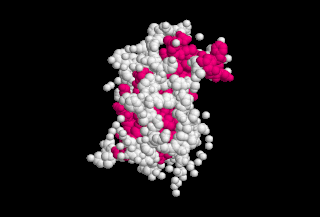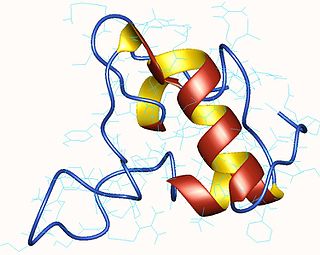 W
WGrowth hormone (GH) or somatotropin, also known as human growth hormones in its human form, is a peptide hormone that stimulates growth, cell reproduction, and cell regeneration in humans and other animals. It is thus important in human development. GH also stimulates production of IGF-1 and increases the concentration of glucose and free fatty acids. It is a type of mitogen which is specific only to the receptors on certain types of cells. GH is a 191-amino acid, single-chain polypeptide that is synthesized, stored and secreted by somatotropic cells within the lateral wings of the anterior pituitary gland.
 W
WBovine somatotropin or bovine somatotrophin, or bovine growth hormone (BGH), is a peptide hormone produced by cows' pituitary glands. Like other hormones, it is produced in small quantities and is used in regulating metabolic processes. After the biotech company Genentech discovered and patented the gene for BST in the 1970s, it became possible to synthesize the hormone using recombinant DNA technology to create recombinant bovine somatotropin (rBST), recombinant bovine growth hormone (rBGH), or artificial growth hormone. Four large pharmaceutical companies, Monsanto, American Cyanamid, Eli Lilly, and Upjohn, developed commercial rBST products and submitted them to the US Food and Drug Administration (FDA) for approval. Monsanto was the first firm to receive approval. Other countries also approved rBST for commercial use. Monsanto licensed Genentech's patent, and marketed their product as "Posilac". In October 2008, Monsanto sold this business, in full, to Eli Lilly and Company for $300 million plus additional consideration.
 W
WGigantism, also known as giantism, is a condition characterized by excessive growth and height significantly above average. In humans, this condition is caused by over-production of growth hormone in childhood, resulting in people 7 to 9 ft in height.
 W
WGrowth hormone deficiency (GHD) is a medical condition resulting from not enough growth hormone (GH). Generally the most noticeable symptom is that an individual attains a short height. Newborns may also present low blood sugar or a small penis size. In adults there may be decreased muscle mass, high cholesterol levels, or poor bone density.
 W
WThe hypothalamic–pituitary–somatotropic axis, or hypothalamic–pituitary–somatic axis, also known as the hypothalamic–pituitary–growth axis, is a hypothalamic–pituitary axis which includes the secretion of growth hormone from the somatotropes of the pituitary gland into the circulation and the subsequent stimulation of insulin-like growth factor 1 production by GH in tissues such as, namely, the liver. Other hypothalamic–pituitary hormones such as growth hormone-releasing hormone, growth hormone-inhibiting hormone, and ghrelin (GHS) are involved in the control of GH secretion from the pituitary gland. The HPS axis is involved in postnatal human growth. Individuals with growth hormone deficiency or Laron syndrome show symptoms like short stature, dwarfism and obesity, but are also protected from some forms of cancer. Conversely, acromegaly and gigantism are conditions of GH and IGF-1 excess usually due to a pituitary tumor, and are characterized by overgrowth and tall stature.
 W
WLaron syndrome (LS), also known as growth hormone insensitivity is an autosomal recessive disorder characterized by a lack of insulin-like growth factor 1 (IGF-1)(somatomedin) production in response to growth hormone (GH)(hGH)(somatotropin). It is usually caused by inherited growth hormone receptor (GHR) mutations.
 W
WSomatomedins are a group of proteins produced predominantly by the liver when growth hormones act on target tissue. Somatomedins inhibit the release of growth hormones by acting directly on anterior pituitary and by stimulating the secretion of somatostatin from the hypothalamus.
 W
WThe murder of Karel Van Noppen was a high-profile assassination of a government livestock inspector in Belgium in 1995. Van Noppen had been investigating illegal practices by farmers and businessmen in Belgium and was shot dead by assailants outside his house in the village of Wechelderzande in the Province of Antwerp. A number of people connected with the illegal supply of growth hormones to livestock were sentenced in connection with the murder.